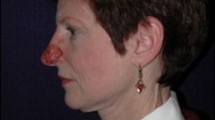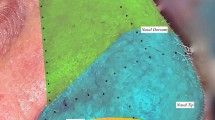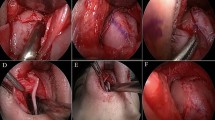Abstract
Reconstruction of nasal defects secondary to Mohs micrographic surgery (MMS) presents particular challenges related to the complex topography, skin quality, tissue laxity, and functional and aesthetic concerns of the region. Factors affecting outcomes resulting from second intent healing (SIH) on the nose have not been well described. The purpose of the study was to identify factors impacting outcomes of SIH for nasal tumors following MMS. Retrospective analysis was performed of all nasal lesions treated with MMS followed by SIH from a single surgical center over a 1.5-year period. Ninety-six cases were included. Chart review was performed, and data were collected including age, gender, nasal site, tumor type, defect size, depth, and number of MMS stages. Pre- and post-operative follow-up photographs were available for all cases. All five authors evaluated the photographs using the modified Manchester scar scale. Analysis was then conducted to identify features associated with good outcomes. Of the 96 tumors, 39 lesions (40.6%) were located on the nasal tip (including supratip), 32 (33.3%) on the ala/alar groove, 17 (17.7%) on the sidewall, and 8 (8.3%) on the dorsum. The average defect size was 0.83 cm2 (diameter of 1.06 cm ± 0.4). Defect diameter and defect depth were the factors that significantly impacted scar outcome (p < 0.001) in multivariate analysis. No significant functional deficits were reported. This retrospective study suggests that nasal defects with area less than 0.83 cm2 (or 1.06 cm diameter) and depth of defect not extending beyond the superficial fat healed well by SIH regardless of location on the nose.



Similar content being viewed by others
References
Bradford PT (2009) Skin cancer in skin of color. Dermatol Nurs 21(4):170–178
Bolognia J et al (2012) Dermatology. Elsevier Saunders, Philadelphia
Ge NN, McGuire JF, Dyson S, Chark D (2009) Nonmelanoma skin cancer of the head and neck II: surgical treatment and reconstruction. Am J Otolaryngol 30(3):181–192
Mott KJ, Clark DP, Stelljes LS (2003) Regional variation in wound contraction of Mohs surgery defects allowed to heal by second intention. Dermatol Surg 29:712–722
Zitelli JA (1983) Wound healing by secondary intention. A cosmetic appraisal. J Am Acad Dermatol 9:407–415
Cook JL, Perone JB (2003) A prospective evaluation of the incidence of complications associated with Mohs micrographic surgery. Arch Dermatol 139:143–152. https://doi.org/10.1001/archderm.139.2.143
Jang JU et al (2016) Comparison of the effectiveness of ablative and non-ablative fractional laser treatments for early stage thyroidectomy scars. Arch Plast Surg 43(6):575–581
Liu KY, Silvestri B, Marquez J, Huston TL (2020) Secondary intention healing after Mohs surgical excision as an alternative to surgical repair: evaluation of wound characteristics and esthetic outcomes. Ann Plast Surg 85(S1 Suppl 1):S28–S32. https://doi.org/10.1097/SAP.0000000000002330
Qian YL, Zhang YX, Yang J, Wang DR, Zhang YG (2005) Microsurgical reconstruction of the nasal subunit defects. Chin J Plastic Surg 21(6):457–460
Weathers WM, Koshy JC, Wolfswinkel EM, Thornton JF (2013) Overview of nasal soft tissue reconstruction: keeping it simple. Semin Plast Surg 27(2):83–89. https://doi.org/10.1055/s-0033-1351226
Rahman M, Jefferson N, Stewart DA, Oliver R, Walsh WR, Gianoutsos MP (2010) The histology of facial aesthetic subunits: implications for common nasal reconstructive procedures. J Plast Reconstr Aesthet Surg 63(5):753–756. https://doi.org/10.1016/j.bjps.2009.02.066
Rittié L (2016) Cellular mechanisms of skin repair in humans and other mammals. J Cell Commun Signal 10(2):103–120. https://doi.org/10.1007/s12079-016-0330-1
Hoasjoe DK, Stucker FJ (1995) Rhinophyma: review of pathophysiology and treatment. J Otolaryngol 24(1):51–56
Goldwyn RM, Rueckert F (1977) The value of healing by secondary intention for sizeable defects of the face. Arch Surg 112(3):285–292. https://doi.org/10.1001/archsurg.1977.01370030057010
Author information
Authors and Affiliations
Corresponding author
Additional information
Publisher's Note
Springer Nature remains neutral with regard to jurisdictional claims in published maps and institutional affiliations.
Rights and permissions
About this article
Cite this article
Kim, D.NW., Kibbi, N., Christensen, S.R. et al. Factors affecting outcomes of second intent healing of nasal defects after Mohs micrographic surgery. Arch Dermatol Res 315, 67–73 (2023). https://doi.org/10.1007/s00403-021-02306-y
Received:
Revised:
Accepted:
Published:
Issue Date:
DOI: https://doi.org/10.1007/s00403-021-02306-y




